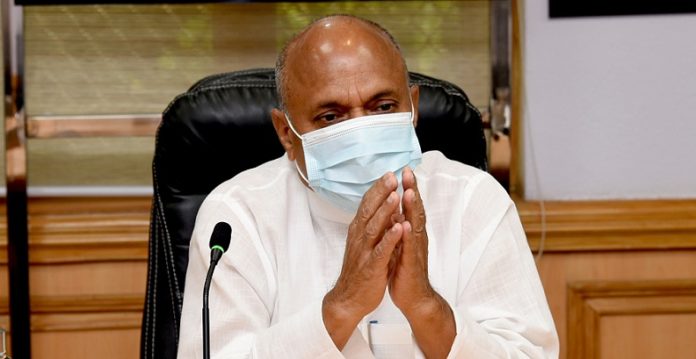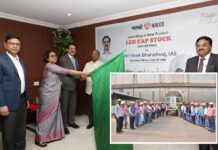By Our Correspondent
NEW DELHI/BHUBANESWAR: Union Minister of Steel Shri Ram Chandra Prasad Singh in a written reply in the Rajya Sabha on Monday said, the present annual crude steel capacity of the country is 144 MT and is envisaged to reach 300 MT by 2030-31. National Steel Policy, 2017 aims to provide the conducive environment for attaining this objective by providing policy support and guidance to steel producers.
The priority for this sector is evident from the fact that 40% of investment in manufacturing sector in India has been made by companies in the steel sector during 2020-21*. Further, after analysing the data, several initiatives have been taken by the Ministry of Steel to increase usage of domestically manufactured steel and import substitution.
(i) Notification of Domestically Manufactured Iron & Steel Products (DMI&SP) Policy for promoting procurement of Made in India steel.
(ii) Notification of Steel Scrap Recycling Policy to enhance the availability of domestically generated scrap.
(iii) Production-Linked Incentive (PLI) Scheme for Specialty Steel with an outlay of ₹6,322 crores.
Joint Plant Committee (JPC) and Institute for Steel Development and Growth (INSDAG) along with Ministry of Steel have evolved a roadmap for increasing the use of steel in various infrastructure sectors. Initiatives taken towards this, include the following:
(i) Ministry of Steel organised Workshops in Feb., 2020 at New Delhi, Mumbai and Bhubaneswar and Webinar in Jan., 2022 in collaboration with the Ministry of Economy, Trade & Industry (METI), Japan by engaging Japanese experts on enabling procedures for increase of steel usage for the growth of economy – Building and Construction Sector.
(ii) To enhance domestic steel usage in Railways and Defence Sector a workshop was organized in Feb., 2020 in collaboration with Ministry of Railways and Ministry of Defence.
(iii) To enhance usage of domestically manufactured steel in Oil and Gas Sector, a webinar was organized in collaboration with Ministry of Petroleum and Natural Gas in June, 2020.
(iv) To enhance domestic steel usage in Building & Construction Sector and Civil Aviation Sector a workshop was organized in collaboration with Ministry of Housing and Urban Affairs and Ministry of Civil Aviation in August, 2020.
(v) To enhance domestic steel usage in Rural India, a workshop was organized in collaboration with Ministry of Rural Development, Ministry of Agriculture & Farmers Welfare, Department of Animal Husbandry and Ministry of Food Processing and Industries in October, 2020.
(vi) Further, a Joint Working Group (JWG) having members from Ministry of Housing and Urban Affairs, Ministry of Skill Development, Ministry of Steel, BIS, CPWD, Technical Institutions (IITs) and from Industry has also been setup for fostering steel usage in Housing and Construction sector. JWG held 03 meetings and the Core Committee under JWG held more than 10 meetings so far.
(vii) Ministry of Steel has also formed a Committee of experts from INSDAG, IITs, Ministry of Road Transport and Highways (MoRTH) and industry experts for development of designs for long span (30m, 35m and 40m) steel based Bridges. The design for 30m is finalised and submitted on 4.1.2022.
(viii) A Committee has been formed jointly with Ministry of Petroleum and Natural Gas to prepare a roadmap for promoting domestic steel in Oil and Gas Sector in September, 2020. The Committee has submitted the final report in August, 2021.
Ministry of Steel is providing financial assistance for research and development in the steel sector, through the scheme “Promotion of Research & Development in Iron & Steel Sector”.
Steel Authority of India Limited (SAIL) and Rashtriya Ispat Nigam Limited (RINL) have adopted the Best Available Technologies (BAT) available globally, in the modernisation & expansions projects and improved Techno-economic parameters such as reduction in coke rate, increase in Pulverised Coal Injection (PCI) rate, improvement in BF productivity etc. resulting in reduction of CO2 emission intensity from a level of 3.1 t/tcs from 2005 to 2.55 t/tcs in 2021. List of Best Available Technologies deployed are as under.
Best Available Technologies (BATs) adopted by SAIL and RINL are given below:-
Coke Dry Quenching Technology to recover sensible heat from coke from Coke Oven Batteries to produce electricity.Top Pressure Recovery Turbine in Blast Furnaces to recover waste Pressure energy of BF gas to electricity.Sinter Cooler Waste Heat Recovery System in Sinter Plant to produce steam or electricity.
Blast Furnace Hot Stoves Waste Gas Recovery System to utilize the waste to preheat the air entering to stoves. Further, the waste gas at reduced temperature is used to pre heat BF gas & Combustion air.LD Gas recovery system in Steel Melting Shops to recover LD gas from converter blowing for usage as fuel in reheating furnaces.Evaporating cooling system in reheating furnaces of rolling mills to generate process steam.Recuperators/ Pre-heaters to recover sensible heat of waste gases from Rolling Mills Reheating Furnaces and Calcination plant kilns.



























